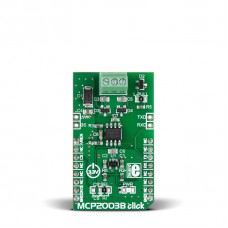MCP2003B click
MCP2003B click is a mikroBUS™ add-on board with a bi-directional LIN transceiver.
It’s a physical interface to automotive and industrial LIN systems, in accordance to the LIN Bus Specifications Revision 2.2, SAE J2602 and ISO 17987. This standard requires that all nodes in the system are to be connected through a LIN bus. Up to 15 slave devices can be connected to a single master.
The click has three onboard screw terminals for connecting the transceiver to a LIN network (three wires: LIN, VBB and GND).
MCP2003B click communicates with the target board MCU through the mikroBUS™ UART interface (RXD, TXD), with additional functionality provided by the VRENDIV and LWAKE pins. Extra pins for LWAKE, CS, and TX and RX are also available above the mikroBUS™.
The board is designed to use a 3.3V power supply only.
Specification
| Type | LIN |
| Applications | Prototyping sensor networks for vehicles |
| On-board modules | Bi-directional LIN transceiver |
| Key Features | MCP2003B IC, Supports baud rates up to 20 Kbaud |
| Key Benefits | High immunity to RF disturbance, ESD, EMI, Multiple operating modes, Compliant with LIN Bus Specs revision 2.2 |
| Interface | GPIO,UART |
| Input Voltage | 3.3V |
| Compatibility | mikroBUS |
| Click board size | M (42.9 x 25.4 mm) |
MCP2003B click is a mikroBUS™ add-on board with a bi-directional LIN transceiver from Microchip.
Features and usage notes
LIN (Local Interconnect Network) is a serial network protocol used for communication between components in vehicles (used in conjunction with CAN).
It’s a physical interface to automotive and industrial LIN systems, in accordance to the LIN Bus Specifications Revision 2.1 and SAE J2602. This standard requires that all nodes in the system are to be connected through a LIN bus. Up to 15 slave devices can be connected to a single master.
The device has four operating modes: power-down (everything except the wake-up pin is shut down), ready (receiver powered up, transmitter disabled), operation (all internal modes operational), and transmitter (when transmitter is disabled).
Programming
This is a simple example of LIN Communication, the master sends data, the first time the slave just receives the data, the second time the slave responds from the response buffer.
1 #include <stdint.h>
2 #include "lin.h"
3
4 sbit tx_pin at LATF4_BIT;
5
6 void main()
7 {
8 uint8_t send_buffer[10] = {0};
9 uint8_t recv_buffer[10] = {0};
10 uint8_t response_buffer[10] = {0};
11
12 UART2_Init( 9600 );
13
14 delay_ms(300);
15
16 send_buffer[0] = 'H';
17 send_buffer[1] = 'E';
18 send_buffer[2] = 'L';
19 send_buffer[3] = 'L';
20 send_buffer[4] = 'O';
21
22 response_buffer[0] = 'H';
23 response_buffer[1] = 'E';
24 response_buffer[2] = 'L';
25 response_buffer[3] = 'L';
26 response_buffer[4] = 'O';
27 response_buffer[5] = 'B';
28 response_buffer[6] = 'C';
29 response_buffer[7] = 'K';
30
31 lin_begin(9600);
32 lin_hal_init();
33 lin_send(50,send_buffer,5,2);
34 lin_slave_receive(50,recv_buffer,2,0);
35 lin_send(50,send_buffer,5,2);
36 lin_slave_receive(50,response_buffer,2,1);
37 lin_slave_receive(50,recv_buffer,2,0);
38
39 while(1);
40 }
Code examples that demonstrate the usage of MCP2003B click with MikroElektronika hardware, written for mikroC for ARM, and PIC32 are available on Libstock.
Downloads
Enter the code in the box below:









